Kristine Billmyer has enjoyed a distinguished career as both a teacher and a higher education administrator for more than two decades. A nationally recognized scholar in her field, she has published widely on cross-cultural variation in language use and the acquisition of sociolinguistic competence by second language learners.
Each year on March 8, International Women’s Day, women around the world remind us that the largest minority in the world is still fighting for parity with men on the World Economic Forum’s four gender equity indicators: educational attainment, health and survival, political empowerment, and economic participation and opportunity.
First Lady Dr. Jill Biden
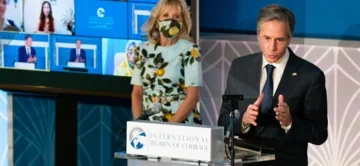
Global Gender Gap Report 2020
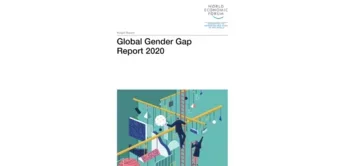
“None of us will see gender parity in our lifetimes, and nor likely will many of our children.” This sobering conclusion was reached by the WEF’s Global Gender Gap Report 2020 that states women lag men on all four indicators, the starkest gap in political empowerment at 75.3%, followed by a recently growing gap of 42.2% in economic participation and opportunity. More alarmingly, the WEF estimates that due to stalling progress in economic participation and opportunity, it will take a staggering 257 years to close that gap. Given the disproportionate toll the pandemic has taken on working mothers, this gap may well extend beyond the year 2277.
During the first week of March, nine students in the Strategic Communication M.S. program joined me and Course Associate Alice Haviland for the course, Gender and Communication in the Workplace: Gia Anderson, Dianna Colasurdo, Valentina Giagnoni, Andrea Greenberg, Amanda Kelly, Adina Isenberg, Iman Khan, Shanty Khurana, Scott Miller, and auditor and Columbia retiree Francina Wearing. Together, we explored the role language plays in perpetuating gender bias, stereotypes, and discrimination, and its potential to enfranchise and emancipate. Here were some of the key constructs, theories, and findings we examined in the course.
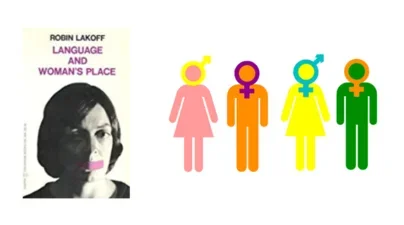
Language as a Restraint
Gender stereotypes are ancient and persistent. One of the earliest English language gender primers, the 16th-century conduct book, A Godly Forme of Household Government, reminds couples of their husbandly and wifely duties with respect to language:
Husband Wife
He the teacher She the hearer
Be skillful in talk Answer in a word; silence, the best ornament
Deal with many men Talk with few
Be ‘intermedling’ Be solitary, withdraw
Fast-forward 400 years to the early 1970s. Post-structuralism was reexamining social structures, including the categories of male and female, and concluded that they were the result of historical forces of power and oppression, not, as previously thought, of biological differences. Once gender was regarded as socially constructed, language theorists began to examine the ways everyday communicative practices helped to create, sustain, and continually change membership in these categories. During that time newly minted Berkley linguistics professor Robin Lakoff published "Talking Like a Lady" (1973) and "Language and Woman’s Place" (1975).
Lakoff argued that women use linguistic features such as hedges (e.g. "perhaps," "maybe"), inessential qualifiers (e.g. "so very nice"), and tag questions (e.g. "It’s a good report, isn’t it?") that render their speech tentative, trivial, and powerless, and that disqualify them from positions of power and authority. In that way, language functions as a tool of oppression, imposed by societal norms to keep women in their place.
Empirical research that followed Lakoff’s work evolved quickly. Early studies posed simplistic questions and resulted in reinforcing male/female, masculine/feminine binaries: men dominate turn-taking, take longer and more frequent turns, and interrupt more than women. Women apologize, compliment, and commiserate more than men.
Candace West’s 1984 study of interruptions in doctor/patient consultations was one example of research that examined both status and gender to see how dominance and control are constituted by participants. She found:
- Male doctors interrupted both male and female patients at twice the rate patients interrupted doctors.
- With female doctors, 68% of the interruptions were done by her patients, and the majority of those interruptions were by male patients.
West concluded that the findings supported conventional descriptions of asymmetry in power-different relationships (e.g. doctor-patient, employer-employee). However, when doctors were female, the locus of power shifted, giving gender primacy over both status and role authority—thus attributing to gender the rank of a master attribute.
Interest in the circulation of gender stereotypes, implicit bias, and the power of normative expectations inspired a third wave of empirical research on language and gender in the workplace. Holmes (2006), Ladegaard (2011), and others confirmed that descriptive and prescriptive norms lead to beliefs about not only how men and women are perceived to speak, but also how they are supposed to speak.
Normatively Masculine Ways of Speaking
Competitive, directive, assertive
Conversationally dominant in public
Terse, silent (long turns, aggressive interruptions)
Autonomous/Minor contribution (in public)
Impersonal, task- and outcome-oriented
Referentially oriented
Normatively Feminine Ways of Speaking
Facilitative, collaborative
Conciliatory, apologetic
Shows interest, attention, support (e.g. "uh," "hmm," "I see")
Invites others to speak
Personal experience to persuade
Affectively oriented, establish rapport
By examining the strategies male and female managers use and how their subordinates perceive and respond to them, they found:
- Both men and women leaders are contextually sensitive, and use a more indirect, inclusive management style.
- Men have a broader repertoire of masculine and feminine strategies than women.
- Whereas male leaders’ authority is never questioned, female leaders are frequently challenged, and their authority is often questioned by male subordinates.
The femininity-competence double bind depicts precisely the challenge women have in creating demeanors of authority in the workplace: "When a female leader enhances her assertiveness or exerts her power, she risks undermining her femininity. When her behavior fits the expectations of how a woman should talk, she risks undermining her competence, authority, and status as a leader" (Tannen 1998:203).
Normative expectations continue to play a prominent role in society, and put women at a distinct disadvantage at critical moments in their careers. Studies of men and women negotiating salary increases show that women who ask for raises are treated more harshly than men, and are viewed as less likeable and desirable as colleagues. Anticipating backlash, women hesitate, hedge, lower their ask, and receive on average 30% less than male negotiators. Women internalize these norms and are more hesitant to ask, have higher levels of self-doubt, and lower levels of self-confidence. The compounding impact over the course of a women’s career may help to explain the persistence of male/female wage and salary gaps at the current levels reported by the WEF.
Shifting Views: Language as a Resource
In the early 2000s, research in language and gender began to challenge the view of language as a tool of oppression that all women suffer under. This important shift signaled movement toward the view of language as a new resource for constructing gender identity, selves, and personae, and an opportunity to reassess the value of normatively feminine discourse.
Situated workplace studies that combined large scale observational data collection with ethnographic methods finally offered a comprehensive representation of language in contexts of leadership and management use. These studies detailed the nature of normatively feminine "relational practices" (RPs), and their worth to the strategic and business goals of organizations. Indeed, this reappraisal cast RPs as indispensable capabilities, core to effective teamwork, and to the well-being of individuals and the organization itself. Other research has gone a step further, exposing positive relationships between feminine communicative practices and leadership capabilities, as well as better medical outcomes and more equitable community resource allocation.
Relational Practices include preserving face, mentoring, empowering, and empathic and inclusive leadership. They are carried out linguistically, through lexical choices that often denote unity (e.g. the inclusive “we”) and speech acts of solidarity (e.g. giving approval, appreciating); interactionally, through sharing turns and floor, soliciting input, and collaborative humor; and nonverbally, through gestures, gaze, facial expressiveness, and vocal quality. The presence of some of these features is seen in New Zealand Prime Minister Jacinda Ardern’s message after the Christchurch massacre in 2019.
Jacinda Ardern

Joe Biden's Thanksgiving Address
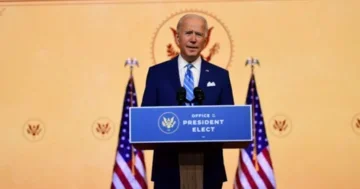
In this image (above left), Ardern’s gestures, facial expressiveness, and head scarf combine powerfully with her words, depicting an understanding of the emotional context in which leadership can be best carried out, in this case by embracing the country’s common humanity.
Normatively feminine discourse practices are not the sole domain of women. Notably, powerful male leaders have moved into these communicative spaces, as Joseph Biden demonstrated in this Thanksgiving Day 2020 address to the nation (above right).
It is useful to view this sea change, as women and men’s ability to defy restrictive stereotypes—and even regenerate them—by associating normatively feminine communicative practices with leadership qualities. This Forbes headline offers just such an example.
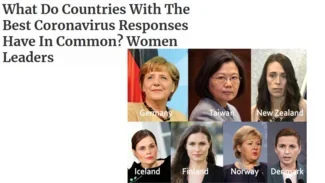
Challenge Restrictive Stereotypes
Women have at their disposal a continuum of choices to manage the double bind that undermines their institutional effectiveness. Men have choices as well, and do not have to abide by the masculine power code, per se.
"Do Femininity" Explicitly
One option is to “do femininity” explicitly by:
- Choosing or creating positive feminine spaces that celebrate gendered norms: pre-meeting talk of families, collaborative/non-abrasive humor, negotiating leadership in non-authoritarian ways (Holmes 2006, Holmes and Schnurr 2006)
- Asserting the value of more feminine discursive styles within male-dominated workplaces
- Challenging the devaluation of behaviors associated with women (explicitly and implicitly)
"Do Power" Explicitly
Another option is to “do power” explicitly by:
- Using fame, position, and platform, and adopting communication strategies that exploit the masculine power code
- Unapologetic, direct, blunt language
U.S. Rep. Alexandra Ocasio-Cortez’s recent Tweet to Ted Cruz:
“I am happy to work with Republicans on this issue where there’s common ground, but you almost had me murdered 3 weeks ago so you can sit this one out. Happy to work w/ almost any other GOP that aren’t trying to get me killed. In the meantime, if you want to help, you can resign.”

Megan Rapinoe uses her fame to advocate for pay equity for women athletes, along with her platform, which she lends or protects from being co-opted. Responding to an invitation to the White House in 2019, she said, “I have no interest in extending our platform to him.”

- Contestive and authoritarian style to match their male colleagues: One recalls Vice President Kamala Harris, hand raised, defending her turn against Vice President Pence’s attempted interruptions in the 2020 debate: “If you don’t mind letting me finish, we can have a conversation. OK? Mr. Vice President, I’m speaking. I’m speaking.”
- Jocular humor, vulgarity: Memorable was Megan Rapinoe’s characteristic jubilant vulgarity when she gave a shout-out to New York City, where the US Women’s Soccer Team celebrated their championship: “New York City, you’re the motherfucking best!”
These language choices blatantly contest prevailing feminine discourse norms, and may raise the hackles of many observers. Still unknown is whether regular normatively masculine performances by women will eventually be regarded as unexceptional, thus destabilizing long-established notions of sex- and gender-determined differences.
Traverse the Spectrum of Gendered Communication
A third option is to cultivate a repertoire of features and styles that spans the continuum of gendered communication. Speaker of the House Nancy Pelosi has mastered that capability, and demonstrated its effectiveness in speech and writing on many occasions. In a Fall 2018 Oval Office meeting, when President Trump needled her over what he took to be her tenuous hold on House leadership, she responded, “Mr. President, please don’t characterize the strength that I bring to this meeting as the leader of the House Democrats.”
By examining the nonverbal and verbal components of this statement we can see how she does it. Speaker Pelosi effectively conveys femininity through a suite of nonverbal features. Her breathy vocal quality, mid-range pitch, and soft volume combine with her small stature and matching brightly colored attire and make-up, and mutually reinforce this gendered style.
Speaker Pelosi’s verbal repertoire is more complex, and her choices range from normatively masculine to normatively feminine. She does not hesitate to rebut her challenger with a reprimand in the form of an unmitigated, face-threatening imperative: “don’t characterize.” Her power lexicon, including the imperative, as well as “strength I bring,” “leader,” “House Democrats,” comprises almost 50% of the propositional content of her statement. Within the same short sentence, Speaker Pelosi calls on normatively feminine strategies to soften the reprimand. Starting with the title of address, “Mr. President,” she shows respect and deference. Followed by the positive politeness marker, “please,” she softens the force of the imperative.
Speaker Pelosi “appropriates and subverts” (Ide 2004) these linguistic forms to symbolize her own strength, dignity, and elegance. In doing so, she commands attention and wields authority.
Speakers who can blend empathic, polite, and inclusive linguistic features with direct, unmitigated, even contestive and parodic styles are better able to manage the femininity-competence double bind for themselves and, by extension, broaden notions of femininity beyond normative expectations. Hopefully, at both institutional and societal levels.
“Education is Our Weapon”
Last week, Strategic Communication students examined naturally-occurring data from their own and others’ social and professional communities of practice. They analyzed micro-level linguistic features and interactional practices associated with gendered styles of communication, such as turn control; hesitation phenomena; directness/indirectness; politeness strategies; the use of mitigation/aggravation to soften/intensify face-threatening acts; and nonverbal behaviors, such as volume, vocal quality, pitch, tone, gaze, facial expressiveness, proxemics, and gestures. They looked for meso-level patterns of use that signal who wields and who yields power, and how power relationships are jointly constructed through language. Students also analyzed the case of a troubled organization, in order to explore macro-level institutional forces that create and sustain asymmetries of power and privilege. Students identified points of inflection, openings, and opportunities within the organization, where small gender equity wins can accumulate, and lead to wider systemic change that takes root at institutional and societal levels.
Part 2 of this piece will feature students’ takeaways from the course, including insights they gained into how their own and others' communicative styles function to maintain or interrupt patterned gender bias. It will also explore the ways individuals and institutions can contribute to gender equity and advance opportunities for women to achieve parity with men—prior to the year 2277.
References
Amanatullah, E. T. & M. W. Morris. Negotiating gender roles: Gender differences in assertive negotiating are mediated by women’s fear of backlash and attenuated when negotiating on behalf of others. Journal of Personality and Social Psychology. 98(2) (2010) 256-267. doi:10.1037/a0017094 https://scholar.google.com/scholar?hl=en&as_sdt=0%2C39&as_vis=1&q=journal+of+personality+and+social+psychology+amanatullah&btnG=
Bellace, J. How the Pandemic is Affecting Working Mothers. Knowledge@Wharton Public Policy. September 29, 2020. https://knowledge.wharton.upenn.edu/article/how-the-pandemic-is-affecting-working-mothers/?utm_source=kw_newsletter&utm_medium=email&utm_%E2%80%A6
Bohnet, Iris. What Works: Gender equality by design. Harvard University Press. 2016. https://scholar.harvard.edu/iris_bohnet/what-works
Bowles, H. R., L. Babcock, L. Lai. Social incentives for gender differences in the propensity to initiate negotiations: Sometimes it does hurt to ask. Organizational Behavior and Human Decision Processes. 103 (1) (2007) 84-103. https://wappp.hks.harvard.edu/files/wappp/files/social_incentives_for_gender_differences_in_the_propensity_to_initiate_negotiations-_sometimes_it_does_hurt_to_ask_0.pdf
Eckert, Penelope and Sally McConnell-Ginet. Language and Gender. Cambridge University Press. 2013. https://www.cambridge.org/us/academic/subjects/languages-linguistics/sociolinguistics/language-and-gender-2nd-edition?format=PB
Estes, Z., Felker, S. Confidence Mediates the Sex Difference in Mental Rotation Performance. Archives of Sexual Behavior. 41 (2012) 557–570. https://doi.org/10.1007/s10508-011-9875-5
Global Gender Gap Report 2020. World Economic Forum. http://www3.weforum.org/docs/WEF_GGGR_2020.pdf
Global Gender Gap Report 2020. World Economic Forum Insight Reports. 2019. https://www.weforum.org/reports/gender-gap-2020-report-100-years-pay-equality/country-top-10s#report-nav
Holmes, Janet, 2006. Gendered Talk at Work. Constructing Gender Identity Through Workplace Discourse. Blackwell, Oxford. https://onlinelibrary.wiley.com/doi/book/10.1002/9780470754863
Holmes, J. and S. Schnurr. ‘Doing Femininity’ at Work: More than just relational practice. Journal of Sociolinguistics. 10 (1) (2006) 31-51. https://doi.org/10.1111/j.1360-6441.2006.00316.x
Holmes, J. and M. Stubbe. Power and Politeness in the Workplace: A sociolinguistic analysis of talk at work. Routledge. 2015. https://www.routledge.com/Power-and-Politeness-in-the-Workplace-A-Sociolinguistic-Analysis-of-Talk/Holmes-Stubbe/p/book/9781138809062
Ide, Sachiko. Exploring Women’s Language in Japan in Language and Woman’s Place. Oxford University Press. 2004. 179-186. https://global.oup.com/academic/product/language-and-womans-place-9780195167573?q=Robin%20Lakoff&lang=en&cc=us#
Karpowitz, Christopher F., et al. “Gender Inequality in Deliberative Participation.” The American Political Science Review, vol. 106, no. 3, 2012, pp. 533–547. JSTOR, www.jstor.org/stable/23275432 . Accessed 26 Mar. 2021.
Ladegaard, H. ‘Doing power’ at work: Responding to male and female management styles in a global business corporation. Journal of Pragmatics. 43 (2011) 4-19. https://www.sciencedirect.com/journal/journal-of-pragmatics/vol/43/issue/1
Lakoff, R. Language and Woman’s Place. Language in Society, Vol. 2, No. 1 (April 1973), 45-79. https://www.cambridge.org/core/journals/language-in-society/article/language-and-womans-place/F66DB3D1BB878CDD68B9A79A25B67DE6
Lakoff, R. T. and M. Bucholtz (ed.). Language and Woman’s Place. Oxford University Press. 2004. https://global.oup.com/academic/product/language-and-womans-place-9780195167573?q=Robin%20Lakoff&lang=en&cc=us
Tannen, Deborah and Kendall. Kendall, S and D. Tannen. Gender and language in the workplace in R. Wodak (ed). Gender and Discourse. Sage Publications. 1997. 81-105. https://us.sagepub.com/en-us/nam/gender-and-discourse/book205373
Tsugawa, W., Jena, A.B., Figueroa, J.F., Orav, E. J., Blumenthal, D.M., Jha, A. K. Comparison of hospital mortality and readmission rates for Medicare patients treated by male vs female physicians. Journal of the American Medical Association. 12/19/2016, E1-E8. https://jamanetwork.com/journals/jamainternalmedicine/fullarticle/2593255?resultClick=1
West, Candace. When the Doctor is a “Lady”: Power, status and gender in doctor-patient encounters. Symbolic Interactions 7 (1) Spring 1984. 87-106. https://onlinelibrary.wiley.com/doi/abs/10.1525/si.1984.7.1.87
Wittenberg-Cox, A. What Do Countries with the Best Coronavirus Responses Have in Common? Women Leaders. Forbes April 13, 2020. https://www.forbes.com/sites/avivahwittenbergcox/2020/04/13/what-do-countries-with-the-best-coronavirus-reponses-have-in-common-women-leaders/?sh=146f27df3dec
The views expressed are those of the author and do not necessarily represent the views of any other person or entity.
